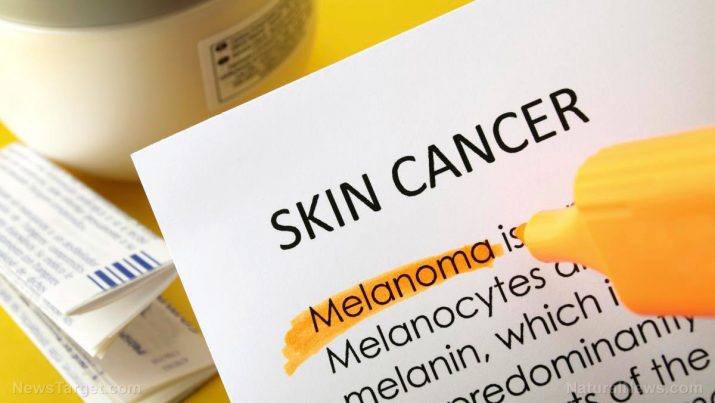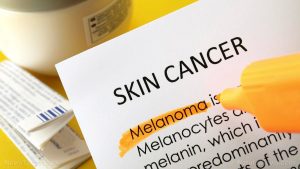
Melanoma – causes, side effects and treatments at NaturalPedia.com
Monday, May 07, 2018 by Zoey Sky
http://www.naturalpedia.com/melanoma-causes-side-effects-and-treatments-at-naturalpedia-com.html

Melanoma is a cancer of the melanocyte or the cell that produces pigment in the skin, and it is the most dangerous type of skin cancer. The first sign of melanoma is usually a notable change in the color, feel, shape, or size of a mole.
In most cases, melanomas have a black or black-blue section. Melanoma may also manifest as a new mole, and it can abnormal, black, or “ugly looking.”
Melanoma is common in people with fair skin, but this form of skin cancer may occur in people of all skin colors.
Melanoma is classified into four clinical types:
- Acral-lentiginous melanoma
- Lentigo maligna melanoma
- Nodular melanoma
- Superficial spreading melanoma

Known side effects of melanoma
Like other forms of cancer, the early stages of melanoma isn’t always easy to detect. Always check your skin for any visible changes. Changes in the appearance of your skin are major indicators of melanoma.
The side effects of melanoma usually include:
- A firm red lump that bleeds or looks ulcerated or crusty.
- A flat, red spot that is dry, rough, or scaly.
- Any skin changes — May include a new spot/mole or a change in the color, shape, or size of a current spot/mole.
- A skin sore that doesn’t heal.
- A spot or sore that turns itchy, painful, tender, or starts bleeding.
- A spot or lump that looks pale, shiny, smooth, or waxy.
Risk factors for melanoma may include:
- Being Caucasian
- Being regularly exposed to sunlight, especially in childhood
- Having close blood relatives (e.g. children, parents, or siblings) with melanoma
- Having fair skin, light-colored eyes, and light hair
- Having “funny looking,” irregular, or large moles
- Having over 100 moles
- Individual sunburns
- Slow daily sun exposure, even without sunburns, can also significantly increase your risk of skin cancer
Body systems harmed by melanoma
Melanoma may cause the following complications:
- An individual who has already had melanoma has a greater risk of developing another melanoma or a different type of skin cancer.
- If a patient has had melanoma in the past, it increases the chance that the condition may return. If their previous cancer was severe and widespread and severe, the chance of the melanoma returning is much higher.
Food items or nutrients that may prevent melanoma
The following foods or nutrients can help prevent melanoma:
- Antioxidants — Foods that contain antioxidants can help lower your risk of developing melanoma cancer. Sources include brussels sprouts, citrus fruits, egg yolks, green tea, pistachios, and zucchini.
- Beetroot — Beetroot has a natural compound chemical called sanguinarine that helps counteract malignant cells.
- Garlic — Garlic has anticancer properties and it also has anti-tumor benefits.
- Green tea — Green tea has anti-oxidants like polyphenols and it can help kill cancerous cells.
- Leafy greens and colored vegetables — Foods eaten raw can help boost the levels of omega-3 and omega-6 oils in your body. Sources include leafy greens, spinach, sweet potato, and yellow or orange vegetables.
- Turmeric — Turmeric contains curcumin that has potent anti-inflammatory and antibacterial effects.
Treatments, management plans for melanoma
Melanoma is treated similarly to other cancers, but it is easier to completely remove it due to its accessible location.
- Skin graft — This is usually done when the melanoma covers a large area of skin. A lymph node biopsy is required for cancer that has penetrated into the lymph nodes.
- Surgery — This form of skin cancer is often treated via surgery, which involves removing the lesion and a bit of the normal tissue surrounding it. A biopsy can also be taken at the same time.
Other uncommon treatments for melanoma include biological therapy (or using medications that work with the immune system), chemotherapy, or photodynamic therapy (involves a combination of light, drugs, and radiation).
Where to learn more
- Common melanoma procedure may not be effective or safe, medical journal warns
- High melanoma risk found in airline crews exposed to high-altitude radiation
- Melanoma breakthrough: Natural fruit and vegetable substance stops skin cancer cells
- Melanoma (skin cancer) found to be easily prevented with low-cost Vitamin B-3
- Prevent Melanoma Naturally
Summary
Melanoma is the most dangerous type of skin cancer. The first sign of melanoma is usually a notable change in the color, feel, shape, or size of a mole. In most cases, melanomas have a black or black-blue section. Melanoma may also manifest as a new mole, and it can abnormal, black, or “ugly looking.”
The side effects of melanoma usually include a firm red lump that bleeds or looks ulcerated or crusty; a flat, red spot that is dry, rough, or scaly; or any skin changes.
Melanoma may cause complications like the development of another melanoma or a different type of skin cancer.
Antioxidants, beetroot, garlic, green tea, leafy greens and colored vegetables, and turmeric can help prevent melanoma.
Melanoma is often treated with a skin graft of surgery. Other methods include biological therapy (or using medications that work with the immune system), chemotherapy, or photodynamic therapy (involves a combination of light, drugs, and radiation).
Sources include:
Tagged Under: Tags: melanoma





